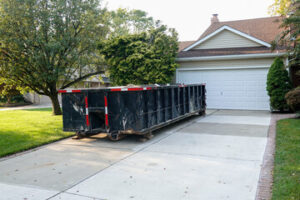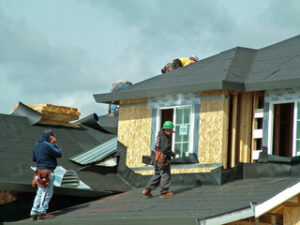When it comes to Dumpster Rental Maryland, it’s important to understand how to properly load and utilize them. This can help you avoid safety hazards and extra fees when the waste disposal company comes to collect the bin.

Start by placing heavy materials like equipment, furniture, and housing fixtures in the bottom of the container. Then, fill in with lighter items such as bags of trash and small debris.
Place The Dumpster In An Accessible Location
The spot where you place your dumpster rental is just as important as the size you choose. You want to make sure that it is easily accessible for loading and doesn’t block any pathways or cause logistical headaches when it comes time to have it removed. An experienced dumpster rental team can help you make these decisions and arrangements to ensure that your waste disposal process is as efficient as possible.
Ideally, your dumpster should be placed on a hard, solid surface that can support the weight of the container without damage. This includes grass, concrete, and asphalt. You should also place a few 4’ x 8’ sheets of plywood on the ground before placing your dumpster, as this will protect the surface from any heavy equipment or traffic that might be driven over it.
It is also a good idea to place your dumpster somewhere that doesn’t obstruct driveways or sidewalks. This can not only cause a safety hazard for pedestrians but can also be a violation of local laws governing dumpster placement. If your dumpster blocks access to a driveway, sidewalk, or public road, you could be fined by your local authorities.
Finally, it is a good idea to consult with your dumpster rental company about any imposed restrictions or limitations. Some items, such as batteries, chemicals, paints, and electronics, require specialized disposal methods that are different than those for general waste. In addition, some items are prohibited altogether, such as hazardous waste, wood, and food scraps.
Taking these precautions will help you avoid any unnecessary penalties or fines when it comes to your dumpster rental. It will also help you get the most out of your rental and complete your waste management project efficiently and safely. Whether you are working on a home improvement project, organizing an event, or conducting any other type of waste management task, the proper placement and utilization of your dumpster will help you complete your job effectively. By following these tips, you can make sure that your rented dumpster is the most effective tool for your job.
Evenly Distribute The Load
If you’re looking for a way to get rid of a lot of waste at once, consider renting a dumpster. These heavy-duty containers can handle large items like old furniture and appliances that most trash collection programs won’t take. But you need to know how to properly load the dumpster to maximize space and minimize costs.
When loading a dumpster, it’s important to evenly distribute the weight throughout the container. This will prevent damage to the dumpster and ensure safe transportation. Start with a layer of bulky items on the bottom and then fill in the gaps with smaller debris. This helps to ensure a compact and secure load and reduce shifting during transport.
You should also try to keep the load level, so avoid overfilling the dumpster. Overfilling may cause the dumpster to tip over during transport, which can pose a safety risk for pedestrians and other drivers on public roads. Additionally, it could result in extra fees or fines from your dumpster rental company.
In addition, you should also try to disassemble large items as much as possible, as this will save space and reduce the overall weight of the load. This will help to reduce the cost of your dumpster rental as well.
Loading a dumpster can be time-consuming, but it’s essential to follow these tips to save money and make the most of your rental. With a little bit of planning, you can have your dumpster delivered and picked up on schedule without spending more than necessary.
If you’re considering renting a dumpster, contact us for guidance on the right size. Our experts can help you select the right dumpster size for your project, as well as provide advice on how to load it efficiently to maximize space. Call us today to learn more about our services or to request a quote. We look forward to hearing from you!
Avoid Overloading
Waste piling up is not only a sight to see, but it also takes up valuable space, pollutes the environment and can lead to safety risks. This is why it’s important to follow certain protocols and adhere to weight limits when using dumpsters for household clean-ups, construction projects, or business waste management. To avoid costly mistakes, it’s essential to know how to properly load and utilize your rented dumpsters. This will maximize efficiency, prevent potential problems, and ensure that your dumpster stays within its maximum fill limit.
Whether you’re a homeowner cleaning out your garage or a contractor on a large commercial project, the proper use of a dumpster can help you save time and money. However, improper dumpster use can result in costly mistakes such as safety hazards, environmental concerns, and additional fees for overfilling or throwing away prohibited items. To avoid these complications, follow the tips below for loading and utilizing your dumpsters like a pro.
When it comes to dumpster placement, the location and surface on which you place your container are just as important as the size of the dumpster itself. The best spot for a dumpster is one that’s easy to access, safe for loading, and doesn’t block traffic or walkways. Also, make sure that the surface is sturdy enough to support the dumpster’s weight without damage.
If you’re planning on renting a dumpster for a large cleanup, make sure that you have a clear plan of how to pack and organize the materials. It’s a good idea to start with larger, bulky items such as old furniture or appliances and then fill in the empty spaces with bags of trash or smaller debris. You can even try stacking smaller items on top of the larger ones to maximize space and minimize the risk of overfilling.
Finally, remember to secure your dumpster with a lock when you’re finished. This will prevent unwanted scavenging from children or other unauthorized people, and it’ll also protect the contents of your dumpster during transportation.
Keep The Container Clean
Regardless of how you load your dumpster, it’s important to keep it clean. The reason is simple: trash left lying around on or near your dumpster can attract pests and critters. In addition, it’s also unsightly and creates a tripping hazard for people working in the vicinity of your dumpster. If you’re cleaning up debris after a big project, make sure to leave enough space for the debris to be easily collected in one place and placed in your dumpster without a lot of maneuvering.
In addition, it’s best to stay within your dumpster’s weight limit. Overloading a dumpster can lead to several problems, including the risk of it falling over during transportation and causing injury to someone on the road or a driver. It can also cause delays in garbage pickup and result in additional fees from the dumpster rental company.
One of the most common errors made by people who rent dumpsters is leaving a lot of loose junk inside the container. This can be hazardous to the people working on a cleanup or project, and it’s not only unsightly, but it can also be dangerous for pedestrians and animals in the neighborhood.
Another mistake that people often make when they rent dumpsters is not putting any materials in the dumpster that cannot be recycled or taken to landfills. Some items, like old tires, are banned from a majority of landfills due to the gasses trapped inside them, which can damage the landfill’s infrastructure and equipment. Rather than throwing these in your dumpster, consider checking with local auto service centers to see if they’ll take them or if there’s another way you can dispose of them.
These six simple tips will help you properly load and utilize your rented dumpsters. From selecting the right spot for your dumpster to distributing the weight evenly, these tips will help ensure that you get the most use and efficiency out of your dumpster rental. By following these simple tips, you can save time, money, and headaches when it comes to completing your cleanup or project.
